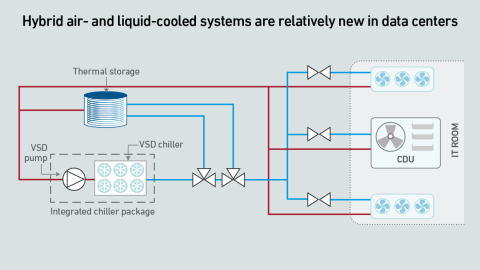Uptime experts discuss and answer questions on grid demands and sustainability strategies while debating how to meet decarbonization goals.
filters
Explore All Topics
Although the data center industry is mostly aware of the EU's Energy Efficiency Directive, Uptime Intelligence's research suggests widespread confusion on specific components of the directive - and its implementation status.
A report by Uptime's Sustainability and Energy Research Director Jay Dietrich merits close attention; it outlines a way to calculate data center IT work relative to energy consumption. The work is supported by Uptime Institute and The Green Grid.
Direct liquid cooling challenges the common "line of demarcation" for responsibilities between facilities and IT teams. Operators lack a consensus on a single replacement model-and this fragmentation may persist for several years.
The European Commission has proposed a data center rating scheme/label that is broadly scoped and highly detailed. The label needs to focus on a few key indicators including three meaningful IT infrastructure metrics.
Join Uptime experts as they discuss and answer questions on grid demands and sustainability strategies while debating how to meet decarbonization goals. This is a member and subscriber-only event.
In this session, we explored how these principles of data center operations were applied to support, sustain, and enhance the skills of people supporting the infrastructure.
Cybersecurity has traditionally not been a key focus of attention for data center operators. But cyber incidents are on the rise and concerns are growing. Unaddressed vulnerabilities leave operators at increasing risk from evolving threats.
Although the share of processing handled by the corporate or enterprise sector has declined over the years, it has never disappeared. But there are signs that it may reclaim a more central role.
For the past 15 years, the case for moving workloads out of enterprise data centers and into the cloud and colocation has been strong. Power availability and demand for high-density capacity may change that.
Human error is an increasingly exploited weakness by cyberattackers, leading to data center security breaches and greater risk for enterprises and operators.
To meet the demands of unprecedented rack power densities, driven by AI workloads, data center cooling systems need to evolve and accommodate a growing mix of air and liquid cooling technologies.
Today, GPU designers pursue outright performance over power efficiency. This is a challenge for inference workloads that prize efficient token generation. GPU power management features can help, but require more attention.
The 15th edition of the Uptime Institute Global Data Center Survey highlights the experiences and strategies of data center owners and operators in the areas of resiliency, sustainability, efficiency, staffing, cloud and AI. The attached data files…
The past year warrants a revision of generative AI power estimates, as GPU shipments have skyrocketed, despite some offsetting factors. However, uncertainty remains high, with no clarity on the viability of these spending levels.
 Max Smolaks
Max Smolaks
 Jay Dietrich
Jay Dietrich
 Jay Paidipati
Jay Paidipati
 Peter Judge
Peter Judge

 Dr. Tomas Rahkonen
Dr. Tomas Rahkonen

 Andy Lawrence
Andy Lawrence

 Jacqueline Davis
Jacqueline Davis



 Madeleine Kudritzki
Madeleine Kudritzki
 Rose Weinschenk
Rose Weinschenk

 John O'Brien
John O'Brien






 Paul Carton
Paul Carton
 Anthony Sbarra
Anthony Sbarra
 Laurie Williams
Laurie Williams

 Daniel Bizo
Daniel Bizo
